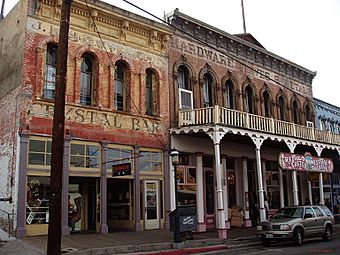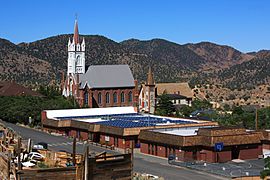Virginia City Historic District (Virginia City, Nevada) facts for kids
|
Virginia City Historic District
|
|
 |
|
| Lua error in Module:Location_map at line 420: attempt to index field 'wikibase' (a nil value). | |
| Location | Virginia City, Nevada, United States |
|---|---|
| Area | 14,750 acres (59.7 km2) |
| Built | 1859 |
| Architectural style | Bungalow/craftsman, Late Victorian |
| NRHP reference No. | 66000458 |
Quick facts for kids Significant dates |
|
| Added to NRHP | October 15, 1966 |
| Designated NHLD | July 4, 1961 |
The Virginia City Historic District is a very special historical area in Nevada, United States. It's so important that it's called a National Historic Landmark. This district includes old mining towns like Virginia City and Gold Hill in Storey County. It also includes Dayton and Silver City in nearby Lyon County. This whole area became a National Historic Landmark in 1961. It's one of only six such places in the entire state of Nevada!
Virginia City was like a blueprint for other mining towns that popped up on the frontier. It grew very quickly into a busy, industrial place. This amazing growth happened because of a huge discovery in 1859 called the Comstock Lode. This was a massive amount of silver and gold found deep underground.
The town of Virginia City was built in a neat grid pattern. It sits about 1,500 feet below the top of Mount Davidson. Many of its buildings are two or three stories tall and made of brick. The first floors were often used as saloons (old-fashioned restaurants and bars) and shops. Virginia City was the first town to experience a "silver rush." It was also the first to use big, industrial ways of mining.
Contents
Life in a Mining Boomtown
Just one year after it started, this busy boomtown had 42 saloons and 42 stores. There were also 6 restaurants, 3 hotels, and 868 homes. About 2,345 people lived there. At its busiest in 1863, Virginia City had 15,000 residents!
Life in a mining town could be tough. Between 1859 and 1875, five big fires swept through the town. The worst one was the "Great Fire of 1875." It caused a huge amount of damage, costing about $12 million at the time.
Protecting History Today
Virginia City is still very popular. Over 2 million visitors come each year to see its historic sites. However, some of the old buildings faced challenges in 2004. An old, unused mining pit might cause some buildings to slide into it.
Sadly, the old cemeteries have been damaged by vandals. Erosion, which is when wind and water wear away the land, also threatens more damage. While tourism helps the town, it can also wear down the historic buildings that are still in use. Buildings that are privately owned and not used are sometimes neglected. This neglect can harm the historical feel of the entire district. It's important to protect these special places for the future.
Important Historic Buildings
The Virginia City Historic District has many important buildings. These buildings help tell the story of the town's past. Here are a few examples:
- First Presbyterian Church: Built in 1867, this is the only church from before the big 1875 fire that is still standing.
- Fourth Ward School: This school was built in 1876. It was used as a school until 1936 and is now a museum.
- Knights of Pythias Building: Built in 1876, this building has cool cast iron and brick.
- St. Mary's in the Mountains Catholic Church: The original church from 1868 was destroyed by the 1875 fire. It was rebuilt in 1876–77 and is still open for services today.
- St. Paul's Episcopal Church: Like St. Mary's, the first church from 1862 was lost in the 1875 fire. It was rebuilt in 1876 and also still holds services.
- Storey County Courthouse: Built in 1876–77, this brick building replaced the first courthouse lost in the fire. It is still used today!
- Territorial Enterprise building: This building from the 1870s is famous because the writer Mark Twain worked there as a reporter.
Images for kids
-
Piper's Opera House (2009)
-
Saint Mary's and Saint Paul's (2016)
-
Territorial Enterprise (2016)






